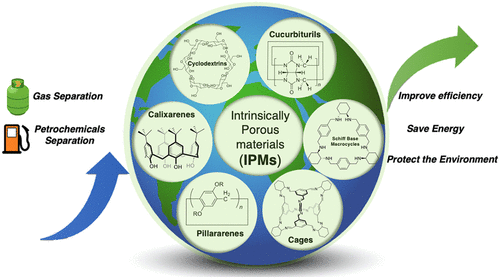当前位置:
X-MOL 学术
›
Acc. Chem. Res.
›
论文详情
Our official English website, www.x-mol.net, welcomes your
feedback! (Note: you will need to create a separate account there.)
Intrinsically Porous Molecular Materials (IPMs) for Natural Gas and Benzene Derivatives Separations
Accounts of Chemical Research ( IF 16.4 ) Pub Date : 2020-12-17 , DOI: 10.1021/acs.accounts.0c00582 Gengwu Zhang 1 , Bin Hua 1 , Avishek Dey 1 , Munmun Ghosh 1 , Basem A. Moosa 1 , Niveen M. Khashab 1
Accounts of Chemical Research ( IF 16.4 ) Pub Date : 2020-12-17 , DOI: 10.1021/acs.accounts.0c00582 Gengwu Zhang 1 , Bin Hua 1 , Avishek Dey 1 , Munmun Ghosh 1 , Basem A. Moosa 1 , Niveen M. Khashab 1
Affiliation

|
Separating and purifying chemicals without heat would go a long way toward reducing the overall energy consumption and the harmful environmental footprint of the process. Molecular separation processes are critical for the production of raw materials, commodity chemicals, and specialty fuels. Over 50% of the energy used in the production of these materials is spent on separation and purification processes, which primarily includes vacuum and cryogenic distillations. Chemical manufacturers are now investigating modest thermal approaches, such as membranes and adsorbent materials, as they are more cognizant than ever of the need to save energy and prevent pollution. Porous materials, such as zeolites, metal–organic frameworks (MOFs), and covalent organic frameworks (COFs), have dominated the field of industrial separations as their high surface areas and robust pores make them ideal candidates for molecular separations of gases and hydrocarbons. Separation processes involving porous materials can save 70%–90% of energy costs compared to that of thermally driven distillations. However, most porous materials have low thermal, chemical, and moisture stability, in addition to limited solution processability, which tremendously constrain their broad industrial translation. Intrinsically porous molecular materials (IPMs) are a subclass of porous molecular materials that are comprised of molecular host macrocycles or cages that absorb guests in or around their intrinsic cavity. IPMs range from discrete porous molecules to assemblies with amorphous or highly crystalline structures that are held together by weak supramolecular interactions. Compared to the coordination or dynamic covalent bond-constructed porous frameworks, IPMs possess high thermal, chemical, and moisture stability and maintain their porosity under critical conditions. Moreover, the intrinsic porosity endows IPMs with excellent host–guest properties in solid, liquid (organic or aqueous), and gas states, which can be further utilized to construct diverse separation strategies, such as solid–gas adsorption, solid–liquid absorption, and liquid–liquid extraction. The diversity of host–guest interactions in the engineered IPMs affords a plethora of possibilities for the development of the ideal “molecular sieves”. Herein, we present a different take on the applicability of intrinsically porous materials such as cyclodextrin (CD), cucurbiturils (CB), pillararene (P), trianglamines (T), and porous organic cages (POCs) that showed an impressive performance in gas purification and benzene derivatives separation. IPMs can be easily scaled up and are quite stable and solution processable that consequently facilitates a favorable technological transformation from the traditional energy-intensive separations. We will account for the main advances in molecular host–guest chemistry to design “on-demand” separation processes and also outline future challenges and opportunities for this promising technology.
中文翻译:

用于天然气和苯衍生物分离的本征多孔分子材料(IPM)
在不加热的情况下分离和纯化化学药品将大大减少整个过程的能源消耗和有害的环境足迹。分子分离过程对于生产原材料,商品化学品和特种燃料至关重要。这些材料生产中使用的能源中有50%以上用于分离和纯化过程,主要包括真空蒸馏和低温蒸馏。如今,化学制造商正在研究适度的热学方法,例如膜和吸附材料,因为它们比以往任何时候都更加了解节省能源和防止污染的需求。多孔材料,例如沸石,金属有机骨架(MOF)和共价有机骨架(COF),由于它们的高表面积和坚固的孔隙使其成为气体和碳氢化合物分子分离的理想选择,因此在工业分离领域占据了主导地位。与热驱动蒸馏相比,涉及多孔材料的分离过程可以节省70%–90%的能源成本。然而,除了有限的溶液可加工性之外,大多数多孔材料还具有较低的热,化学和湿气稳定性,这极大地限制了其广泛的工业转化。本质上,多孔分子材料(IPM)是多孔分子材料的一个子类,它由分子宿主大环或笼子组成,这些大环或笼子在其固有腔中或周围吸收客体。IPM的范围从离散的多孔分子到具有通过弱超分子相互作用保持在一起的无定形或高度结晶结构的组件。与配位或动态共价键构建的多孔骨架相比,IPM具有较高的热,化学和湿气稳定性,并在关键条件下保持其孔隙率。此外,固有的孔隙度使IPM在固态,液态(有机或水性)和气态下具有出色的主客体性能,可进一步用于构建多种分离策略,例如固气吸附,固液吸收,和液液萃取。工程化IPM中主客互动的多样性为理想的“分子筛”的开发提供了许多可能性。在这里 我们对固有的多孔材料(例如环糊精(CD),葫芦科(CB),柱状芳烃(P),三苯胺(T)和多孔有机笼(POC))的适用性提出了不同的看法,这些气体在气体净化和苯衍生物分离。IPM可以轻松扩展,并且非常稳定且可解决方案,因此有助于从传统的能源密集型分离中进行有利的技术改造。我们将解释分子宿主-客体化学在设计“按需”分离方法方面的主要进展,并概述该有前途技术的未来挑战和机遇。多孔有机笼(POC)在气体净化和苯衍生物分离方面显示出令人印象深刻的性能。IPM可以轻松扩展,并且非常稳定且可解决方案,因此有助于从传统的能源密集型分离中进行有利的技术改造。我们将说明分子宿主-客体化学在设计“按需”分离方法方面的主要进展,并概述该有前途技术的未来挑战和机遇。多孔有机笼(POC)在气体净化和苯衍生物分离方面显示出令人印象深刻的性能。IPM可以轻松扩展,并且非常稳定且可解决方案,因此有助于从传统的能源密集型分离技术进行有利的技术改造。我们将解释分子宿主-客体化学在设计“按需”分离方法方面的主要进展,并概述该有前途技术的未来挑战和机遇。
更新日期:2021-01-05
中文翻译:

用于天然气和苯衍生物分离的本征多孔分子材料(IPM)
在不加热的情况下分离和纯化化学药品将大大减少整个过程的能源消耗和有害的环境足迹。分子分离过程对于生产原材料,商品化学品和特种燃料至关重要。这些材料生产中使用的能源中有50%以上用于分离和纯化过程,主要包括真空蒸馏和低温蒸馏。如今,化学制造商正在研究适度的热学方法,例如膜和吸附材料,因为它们比以往任何时候都更加了解节省能源和防止污染的需求。多孔材料,例如沸石,金属有机骨架(MOF)和共价有机骨架(COF),由于它们的高表面积和坚固的孔隙使其成为气体和碳氢化合物分子分离的理想选择,因此在工业分离领域占据了主导地位。与热驱动蒸馏相比,涉及多孔材料的分离过程可以节省70%–90%的能源成本。然而,除了有限的溶液可加工性之外,大多数多孔材料还具有较低的热,化学和湿气稳定性,这极大地限制了其广泛的工业转化。本质上,多孔分子材料(IPM)是多孔分子材料的一个子类,它由分子宿主大环或笼子组成,这些大环或笼子在其固有腔中或周围吸收客体。IPM的范围从离散的多孔分子到具有通过弱超分子相互作用保持在一起的无定形或高度结晶结构的组件。与配位或动态共价键构建的多孔骨架相比,IPM具有较高的热,化学和湿气稳定性,并在关键条件下保持其孔隙率。此外,固有的孔隙度使IPM在固态,液态(有机或水性)和气态下具有出色的主客体性能,可进一步用于构建多种分离策略,例如固气吸附,固液吸收,和液液萃取。工程化IPM中主客互动的多样性为理想的“分子筛”的开发提供了许多可能性。在这里 我们对固有的多孔材料(例如环糊精(CD),葫芦科(CB),柱状芳烃(P),三苯胺(T)和多孔有机笼(POC))的适用性提出了不同的看法,这些气体在气体净化和苯衍生物分离。IPM可以轻松扩展,并且非常稳定且可解决方案,因此有助于从传统的能源密集型分离中进行有利的技术改造。我们将解释分子宿主-客体化学在设计“按需”分离方法方面的主要进展,并概述该有前途技术的未来挑战和机遇。多孔有机笼(POC)在气体净化和苯衍生物分离方面显示出令人印象深刻的性能。IPM可以轻松扩展,并且非常稳定且可解决方案,因此有助于从传统的能源密集型分离中进行有利的技术改造。我们将说明分子宿主-客体化学在设计“按需”分离方法方面的主要进展,并概述该有前途技术的未来挑战和机遇。多孔有机笼(POC)在气体净化和苯衍生物分离方面显示出令人印象深刻的性能。IPM可以轻松扩展,并且非常稳定且可解决方案,因此有助于从传统的能源密集型分离技术进行有利的技术改造。我们将解释分子宿主-客体化学在设计“按需”分离方法方面的主要进展,并概述该有前途技术的未来挑战和机遇。











































 京公网安备 11010802027423号
京公网安备 11010802027423号